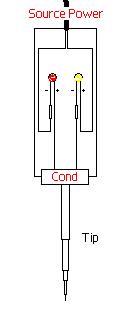led and diodes
Printed From: the12volt.com
Forum Name: Lights, Neon, LEDs, HIDs
Forum Discription: Under Car Lighting, Strobe Lights, Fog Lights, Headlights, HIDs, DRL, Tail Lights, Brake Lights, Dashboard Lights, WigWag, etc.
URL: https://www.the12volt.com/installbay/forum_posts.asp?tid=81707
Printed Date: December 23, 2025 at 2:33 AM
Topic: led and diodes
Posted By: zee4speed
Subject: led and diodes
Date Posted: August 16, 2006 at 8:41 PM
Depicted is a picture of a testlight I'ld like to create.

the "SourcePower" is connected to both positive and negative, and one can follow where they connect to the leds. The "Tip" of this testlight, can tap either positive or negative. The tapping of the powersource will determine which LED lights up. "Cond" Is basically a piece of metal conducting from the tip to both leds. However the problem Im having is that as soon as "SourcePower" is connected, both led's light up. I realized that because of "Cond", its allowing power to be passed between both LEDs. I believe that all I need is two DIODES. Connect one diode to each led between the "Cond" and LED.
So the question is, is this the correct approach? And also which way should I put the diodes in.
Please help.
Replies:
Posted By: KPierson
Date Posted: August 16, 2006 at 10:27 PM
LEDs are diodes, so you shouldn't need to add a diode as you already have the LEDs. However, you will need to limit the current going to the LEDs for your specific voltage range. Sizing this resistor may be difficult if trying to make the LEDs light up over a wide range of voltages. If you are just interested in car voltages (5 and 12vdc) you shouldn't have much problems. You will need the data sheet of the LED and the maximum working voltage to calculate the reesistance for each color of LED you use.
-------------
Kevin Pierson
Posted By: Mad Scientists
Date Posted: August 18, 2006 at 1:08 PM
LED polarity sensitive test lights are already on the market.. you could think of the LEDs on when you plug it in as a 'design feature' to verify you have voltage at the plug, or you could consider two current limiting resistors.. when the probe isn't touching anything the resistors are in series and drop enough current that the LEDs don't light, or come on dim. Ask if you have any more questions.. Jim
Posted By: Cameronjc
Date Posted: August 20, 2006 at 12:58 AM
You are correct, using diodes will produce your desired effect.
I would use / recommend 1N4001. A bit much but they'll work just fine. In fact if you'd like a couple I'll mail them your way if you wanna cover the cost of the stamp.
Posted By: Cameronjc
Date Posted: August 20, 2006 at 1:04 AM
Oh and also, if you needed to know, the stripe stamped on one end of the diode indicates the polarity. (stripe indicates the cathode side).
Posted By: Mad Scientists
Date Posted: August 20, 2006 at 5:37 PM
How/where would you wire in the diodes?..
Posted By: Cameronjc
Date Posted: August 20, 2006 at 11:34 PM
You would put it inline from the conductor to the leds with the stripe facing the LEDs. That way the diode resists the power coming from the LED's via the power source to the conductor, disrupting the circuit. That way the connductor is neither + or - until you touch it to whatever your probing.
Posted By: zee4speed
Date Posted: August 23, 2006 at 11:32 AM
Cameronjc are you sure that would work?
Im not guru, and dont know too much, but a resistor allows positive to flow one way, and negative to flow the other way only. So in my case look at the bulb on the right, the yellow one. It currently gets negative from the red bulb, how could the diode keep it from completing the circuit from the red led's negative and not do the same from the conductors negative charge?
Posted By: Cameronjc
Date Posted: August 23, 2006 at 3:21 PM
Diodes will only allow current to flow through them one way.
Posted By: zee4speed
Date Posted: August 24, 2006 at 10:10 PM
https://www.the12volt.com/diodes/diodes.asp
the above link verifies what I once learned.
Positive Current Can Only Flow From Anode To Cathode
Negative Current Can Only Flow From Cathode To Anode
And in this case, as I wonder, what difference does it make for one led if the negative is flowing from the other Led or from the "Cond". In the end, The diode has to be wired to let either (+)/(-) current through, Im not seeing any way to restrict it from the other led.
Am I making any sense, or am I just totally wrong, or are there any specific diodes that act diffently, than what I'm thinking of.
|
